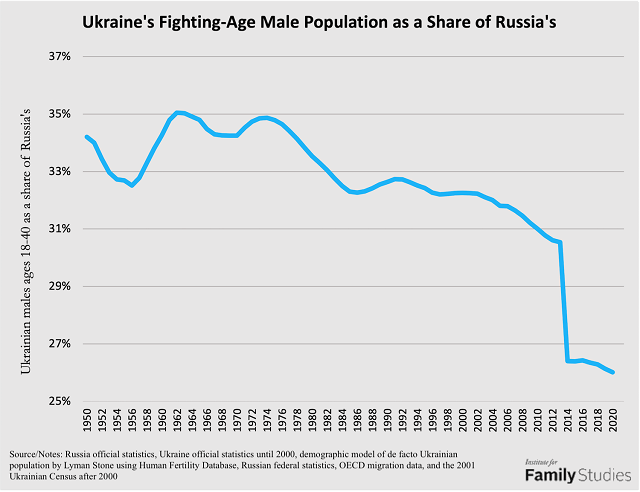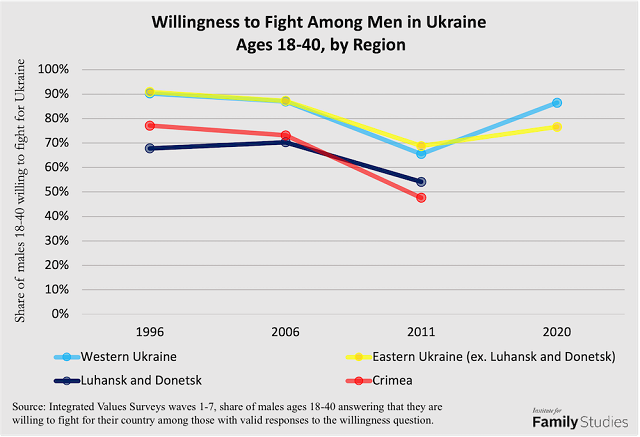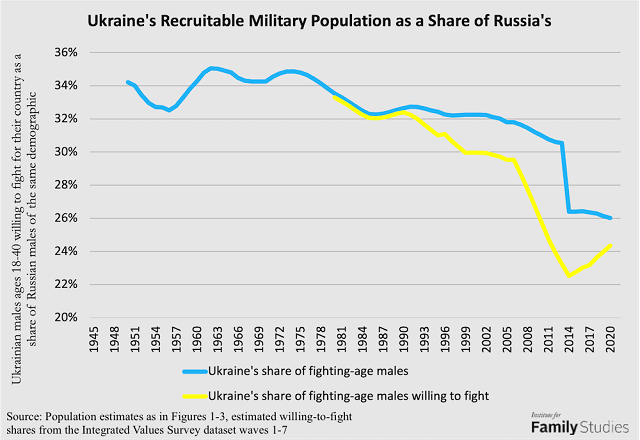Highlights
The ongoing war between Russia and Ukraine has already claimed thousands of lives, military and civilian. It is the largest conflict within Europe since World War II, and the first conventional war in Europe to be fought since the Balkan conflicts of the 1990s. While the present conflict has many causes, some of the factors leading to war are linked to population and demography. Arguments and beliefs about population and demography have been marshaled by both sides to justify various political claims, and demography and social science research can inform expectations about the war. The war will itself alter the demographic trajectory of Ukraine and other countries in the area.
War Planning
Demography is a core part of war. Between World War I and II, France adopted numerous pro-natal policies to try to replace the casualties of the first war, in anticipation that someday there would be a second. Today, Korean generals publicly worry that low Korean birth rates imperil national defense. The barbarian “invasions” of Rome were, as often as not, better described as “armed migrations:” not a foreign power seeking to conquer Roman territory and add it to a foreign state, but rather a foreign people seeking to immigrate into Rome and not taking no for an answer. Wars throughout history have often been accompanied by genocide, ethnic cleansing, or colonial resettlement. Imperial powers from the Assyrians to the Incans to the British relocated whole communities of conquered peoples around their empires to ease imperial control, and mistreated or exterminated other groups as a strategy for control. The famous Prussian general Carl von Clausewitz once said, “War is politics by other means,” but it might just as truly be said that “War is demography by other means.”
And indeed, demography and related survey work were a core part of the leadup to the war in Ukraine. Russia seized Crimea in 2014 because they needed its naval access to the Black Sea; but they believed they would be able to seize Crimea easily because a large majority of Crimeans were Russian-speaking, many were ethnic Russians, and surveys showed that few Crimeans were willing to fight for Ukraine. Population trends created conditions which facilitated military conquest.
The eastern edge of Ukraine has been fighting the Ukrainian government since 2014 as well, which is unsurprising since the far east of Ukraine is the only area outside of Crimea where Russian-speakers and self-identified ethnic Russians were perhaps a majority. Population trends help us understand what kinds of wars might happen.
So what are some relevant population trends in Ukraine and Russia? Here, birth rates are vitally important. Both Russia and Ukraine have low fertility rates, but in recent years, Russia has implemented pro-natal policies that have helped the country avoid extreme fertility declines. In Ukraine on the other hand, a relative lack of family-supportive policies alongside the economic depression and insecurity of war and political upheaval over the last 10-15 years have led to birth rates plummeting to barely over 1 child per woman. For all Ukraine statistics here, I have reconstructed demographic data for the territory actually controlled by Ukraine in each year, accounting for territorial losses.

In other words, the Ukrainian population will shrink by about half over the course of the next generation or two, whereas Russia’s would shrink by just 25%, assuming there is no migration.
Since the fall of communism, Russia has also benefitted from high in-migration from former Soviet countries in Central Asia as migrants from poorer areas move to Russia for work, and ethnic Russians dispersed by the Soviet regime return to Russia. Ukraine, with lower incomes, less of a Soviet-era diaspora, and easier access to Europe, had net out-migration. In recent years, these trends began to reverse, but Ukraine’s high outflows still left it with a sharply falling population.
But “population” isn’t what matters for war. The elderly and children do not make large contributions to the fighting of wars in most cases. Since the majority of combat is carried out by men ages 18 to 40, changes in this population are particularly relevant. Data from the United Nations World Population Prospects can be used to chart out how Ukrainian and Russian populations of men ages 18 to 40 have changed over time. The figure below shows estimates for this “fighting-age male” population.

In both Russia and Ukraine, the population of potential soldiers is in decline. After accounting for the fact that many of these men may not be physically fit for service or may be needed to keep the economy running, the trend becomes even more acute. Ukraine’s loss of Crimea and some eastern regions has been especially damaging.
But here again, despite some broad similarities, Russia has a distinct advantage. Not only does Russia have three times the population of fighting age men in general, but Russia’s decline has been less severe. The figure below uses the same data but instead shows Ukraine’s fighting-age male population as a share of Russia’s.

Ukraine’s position compared to Russia’s is steadily eroding. This trend will continue at an even greater pace in the future as the gaps in fertility rates between the two countries grow wider. As a result, each passing year seems to leave Ukraine in a weaker position in terms of recruitable troops.
The Ukrainian government knows that their long-run demographic position is not very good. Indeed, the growing jeopardy in which the Ukrainians find themselves is a key motive for Ukraine’s foreign policy. As the ability to defend themselves is deteriorating, Ukraine is more actively pursuing allies. The sharp drop over the mid-2000s is particularly striking in this regard, as it saw Ukraine decline, Russia’s potential manpower rise, Russia complete its pacification of the conflict-torn regions in Chechnya, Dagestan, and Ingushetia, and, in 2008, invade Georgia.
Thus, we see the demographic foundations of war.
Worse Than a Crime
Before invading Ukraine, Russian strategists believed that Ukrainians would not put up a fight. Opinion polls conducted by Russia’s intelligence agency confidently informed top planners that:
Trust in the office of the president sat at 27%, with 67% distrustful of the presidency…And when it came to willingness to serve in the military or otherwise resist a foreign invasion, 40% of respondents stated that they would not defend Ukraine.
When Russian strategists looked at Ukraine, the long-run trend not only appeared to be in their favor, but Ukrainians seemed extremely dissatisfied with the way things were going in Ukraine. It seemed unlikely that Ukrainians would fight an invasion. The fact that Russia had seized Crimea practically without firing a shot and routed the Ukrainian army in the eastern provinces of Luhansk and Donetsk in 2014 and 2015 almost certainly reinforced this supposition.
The renowned French statesman and diplomat Talleyrand supposedly commented on Napoleon’s execution of a French royal that it was “Worse than a crime: it was a mistake.” The pithy quote encapsulates the problem facing governments: moral outrages may not threaten a state’s power, but strategic errors do. In Ukraine, Russia miscalculated.
Russia’s miscalculation boils down to essentially a survey error. Russia’s intelligence agency portrayed 40% of people being unwilling to fight as a sign that Ukraine was vulnerable. I don’t have access to their survey data, but I do have various waves of the World Values Survey/European Values Survey from 1996 to 2020 in Ukraine, which asked about willingness to fight. In 2020, 40% of Ukrainians in that survey said they would not fight for their country, identical to the Russian intelligence survey.
But it turns out, those 40% were mostly elderly people and women. The figure below shows the share of men ages 18 to 40 who said they were willing to fight, by region of Ukraine and year of survey.

When Russia secured an easy victory in 2014, it was by invading the parts of Ukraine that were uniquely unwilling to put up a fight. By 2020, Ukraine looked nothing like those regions.
A remarkable transformation occurred in Ukrainian society after 2013. Ukrainian nationalist militias had mobilized for war, and became fixtures of Ukrainian society afterwards, often with the support of Ukraine’s government. Hundreds of thousands of Ukrainian men got experience of war along the skirmish line in eastern Ukraine. The government stoked the fires of nationalism, imposing Ukrainian-language education. Ukraine has found willing soldiers beyond younger men: the man commanding the defense of Mykolaiv is a 56-year-old retiree who reportedly returned to service out of patriotism; a retired mailman shot down a Russian fighter plane; Ukraine managed to convince hundreds of thousands of everyday people that they should fight. Few wars have seen so much gray hair under helmets.
Multiplying these willingness-to-fight shares for Russia and Ukrainian regions by their population of men 18 to 40 years old yields an estimate of how many actually recruitable troops Ukraine had compared to Russia, which is shown below simply as a share of Russia’s similarly-computed manpower.

Between 1980 and 2014, Ukraine’s real military manpower balance with Russia declined at an even faster rate than the raw population numbers suggest. But Ukraine by 2020 was a different country altogether. Despite falling recruitable population, a sharp rise in willingness to fight (alongside increases in Ukrainians’ survey-reported levels of patriotism, trust in neighbors, and belief that their country was a democracy) meant that Ukraine’s real manpower had risen sharply since the defeats of 2014 and 2015. Between 2014 and 2020, I estimate that Ukraine’s “real” manpower rose 1%, while Russia’s declined 6%.
Core demographic factors like birth rates and migration rates matter. They shape the playing field that governments respond to. But they are not destiny: faced with unfavorable demography, Ukraine cultivated allies to supply it with weapons, and cultivated martial nationalist ideologies among its people, and thus turned demographic decline into military rejuvenation. Now, graybeard Ukrainians with British- and American-supplied rockets are destroying hundreds of Russian tanks crewed by young Russians.
The Demographic Effects of War
Demography influences the advent and course of war. But war itself can shape demography in vital ways. Over three million Ukrainians, overwhelmingly women, children, and elders, have fled to nearby Poland, Slovakia, Moldova, and Hungary. Tens of thousands of fighting-age Ukrainian men in the Ukrainian diaspora have moved from abroad back into Ukraine to help fight the Russians. Thousands of people, soldiers and civilians alike, have died. These phenomena can be described in military terms, and of course in humanitarian terms, but they are also at their root demographic processes. Amid the shelling, Ukraine’s demography is being reshaped.
War can change migration and inflict civilian and military casualties. But there are more subtle effects as well, with effects on fertility in particular. Wars obviously can reduce fertility as insecurity and dangerous conditions cause people to avoid having a child. Separation of women from their male partners could also reduce conception, even among those who want a child. But wars can also lead to higher fertility. As men are deployed, sudden bursts of conception sometimes occur (for example, monthly birth data from the 1940s clearly shows that U.S. baby boom began not as the G.I.’s returned from war, but as they were leaving for war). The chaos of war might make it harder to access contraception. Among the horrors of war, rape and sexual violence are frequent occurrences. After a war, lingering effects can be important too: wars may trigger a surge of nationalist ideas making people susceptible to pro-natal ideas and policies, even as so-called “replacement fertility” often leads families to “respond” to high-casualty events by having “replacement” children.
Extensive academic research has found that fertility tends to increase during and after a war in low-income countries, but in middle-income countries, like Ukraine, fertility tends to fall. Fertility “booms” during wars usually occur among young women and unmarried women and may be connected to low contraceptive access and direct exposure to violence (including sexual violence) during war. The use of rape as a weapon of war in this way can constitute genocide under international law but may be less common in middle-income countries like Russia and Ukraine. The likeliest outcome for Ukraine is that birth rates fall even further, as they did in Kuwait, Sri Lanka, and Armenia after other wars in the last few decades.
The dire conclusion is that Ukraine could win the war but still lose the long game of strategic competition. The war will kill many Ukrainians, lead thousands or millions to flee the country, and reduce birth rates. Further intensification of population mobilization (such as by fully including women in conscription, as Israel does) may become necessary to offset this decline, forcing Ukraine to pour more resources into its defense budget, even as it struggles to achieve economic development. Slow economic development in turn will exacerbate out-migration and low fertility. Until Ukraine can find a way to inspire confidence in its people that raising a family there is an important undertaking worth the attendant risks, the present war seems unlikely to be the last one.
Lyman Stone is a Research Fellow at the Institute for Family Studies, Chief Information Officer of the population research firm Demographic Intelligence, and an Adjunct Fellow at the American Enterprise Institute.
Editor’s Note: The opinions expressed in this article are those of the author and do not necessarily reflect the official policy or views of the Institute for Family Studies.















